by Jason Bodner
January 30, 2024
I had a dream recently, one in which a group of us discovered an apparent probe from another world.
Otherwise boringly round, it had some inscriptions. There were some symbols not of this world and it had a map of stars, made by laser-like cuts in relief. The only problem was that this map of the stars didn’t match any of our constellations, or our understanding of the arrangement of stars from our perspective. It begged so many questions: Who, when and where is it from? Why did they send it? How did it get here?
We knew nothing about it; we only knew we were not alone in the universe. My dream must have been taken from reality. In September of 1977, NASA launched the $250 million Voyager 1 into space to study the outer solar system. It is the first man-made object to leave our solar system. Today, it is more than 15 billion miles away from home, and it took a bit of our home with it: Voyager 1 and 2 were each equipped with a Golden Record, which Carl Sagan prepared for potential extraterrestrials who might find it. The record has inscribed symbols to show the location of Earth relative to several pulsars. It also has greetings in 55 languages, sounds from earth and my personal favorite, music by Mozart and Bach.
Imagine that Voyager 1 or 2 lands safely on some remote planet and quietly sits undiscovered for a million years or so. Would any discoverers even know what to do with it? Perhaps not – but they would at least know that they are not alone, so my dream ended in mystery. No answers – only questions.
There is a point for investors. You care about profiting from markets. Anyone who tells you that it’s easy to invest is either lying or could be an inter-galactic alien. Deciphering market questions can be utterly exciting, frustrating, or very confusing, much like it would be if deciphering a probe from another galaxy.
The way I make sense of this market is by using quantifiable data and stripping out emotion. Despite calls for a crash and the usual doom and gloom talk, the bulk of the data is encouraging. Don’t underestimate the negative human mind. I heard someone yesterday say that they agree that the market is in for good times, “but the only problem is that everyone agrees.” That’s one’s emotions talking. Not “everyone” agrees that good times are ahead, if you read most news reports. I find it better to consult the data.
First, the Big Money Index (BMI) remains overbought.
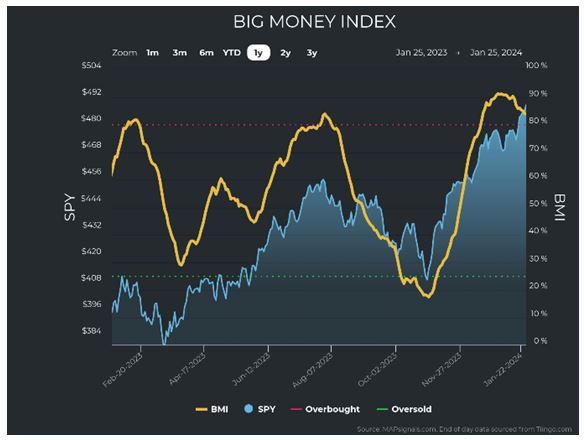
Graphs are for illustrative and discussion purposes only. Please read important disclosures at the end of this commentary.
The BMI can stay overbought for a long time. The BMI went overbought 72 times since 1990, and the historical average staying overbought is 22 days. It went overbought on December 14th – 28 trading days ago, so we are over average, yet the longest overbought period was from June 6 to September 2, 2020, or 84 trading days. No matter, because forward returns have been positive, on average:

Remaining overbought is not bad news. Overbought is constructive for markets, long-term. Still, when the BMI falls from 80, we can expect near-term volatility. Logically, if demand outstrips supply for any duration, it’s a good sign, as the BMI grinds along after vaulting higher in November and December because of one underlying reason: There is more unusual buying than selling. And we can see that healthy buying by looking at stocks and ETFs. Since November, you will see much more green than red.
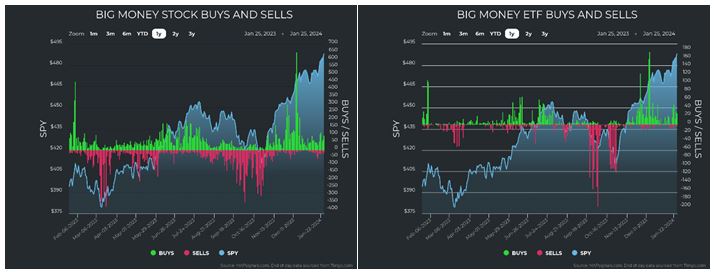
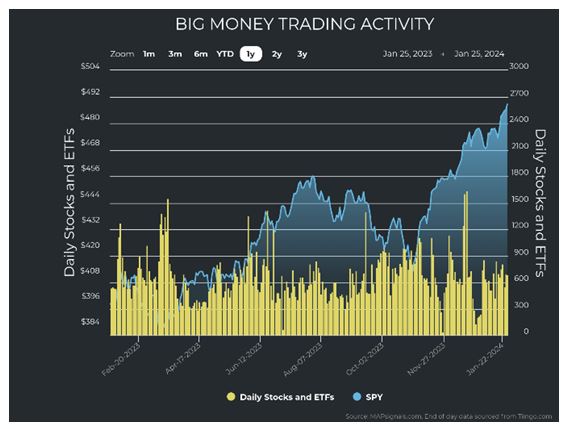
Graphs are for illustrative and discussion purposes only. Please read important disclosures at the end of this commentary.
The Big Money trading activity chart (amber bars, above) shows the uptrend is sustained on substantial volume. Markets that shoot higher on thin volume can be suspect. This chart shows the uptrend is real.
Next, let’s look at what is getting bought. On the left, below, we see a breakdown of buying by market capitalization. We can see that demand was heavy in small-, mid-, and large-cap stocks. This is a healthy and bullish sign as the engines of growth for economies and markets are healthiest when smaller stocks can rise. The chart on the right shows that this is not a new trend. Since November 1st, we see that same pattern. And notice that unusual buying outnumbers selling by more than 5-to-1 since the rally began:
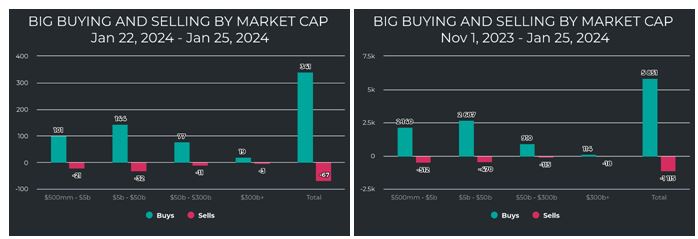
Graphs are for illustrative and discussion purposes only. Please read important disclosures at the end of this commentary.
That’s strong and healthy. Now, let’s look at what has been bought. Again, let’s look at last week versus the span since November 1st. On the left we see last week, and on the right since 11/1/2023:

Graphs are for illustrative and discussion purposes only. Please read important disclosures at the end of this commentary.
The symmetry is lovely and tells a story of growth in demand. We see that echoed in the sector strength:

Graphs are for illustrative and discussion purposes only. Please read important disclosures at the end of this commentary.
Growth sectors – like Technology, Industrials, and Discretionary – are in the top 5. Meanwhile defensive sectors (like Staples, Communication, Materials, and Utilities) are at the bottom.
We can also see that the only sectors experiencing recent selling are Energy and Utilities.

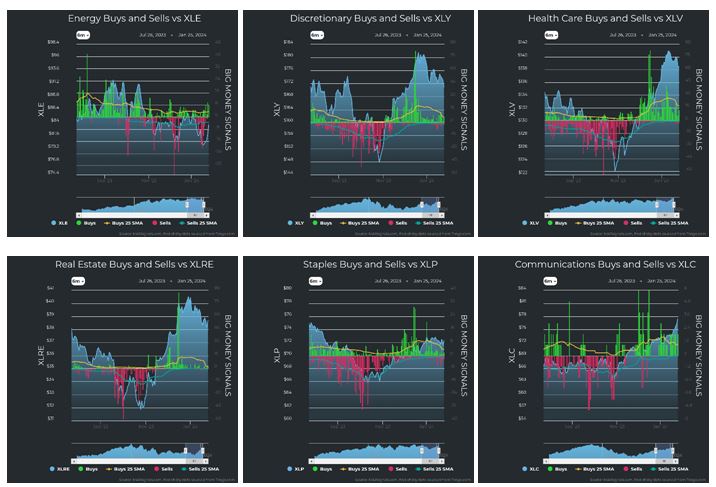

Graphs are for illustrative and discussion purposes only. Please read important disclosures at the end of this commentary.
So, if we step back and analyze our very own “market-probe from outer space,” we can answer these questions:

First, the inflation rate and interest rates are inverted – not a normal relationship. And the spread between the two is huge: Interest rates are about 2% above inflation (the effective Fed funds rate is 36% higher than the Consumer Price Index). Historically, that doesn’t tend to last long, meaning rates will fall.
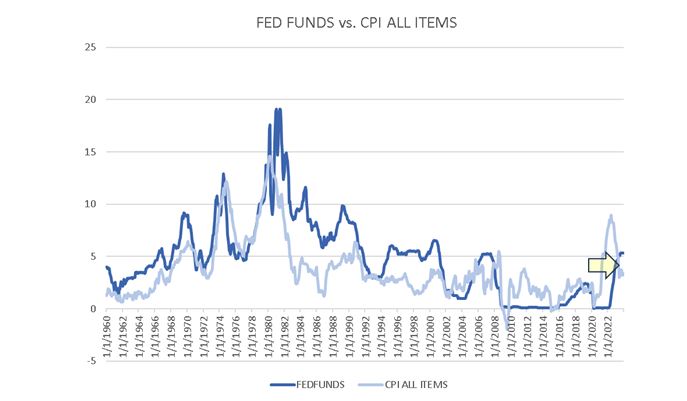
Graphs are for illustrative and discussion purposes only. Please read important disclosures at the end of this commentary.
Secondly, there’s a record amount of cash sitting around.
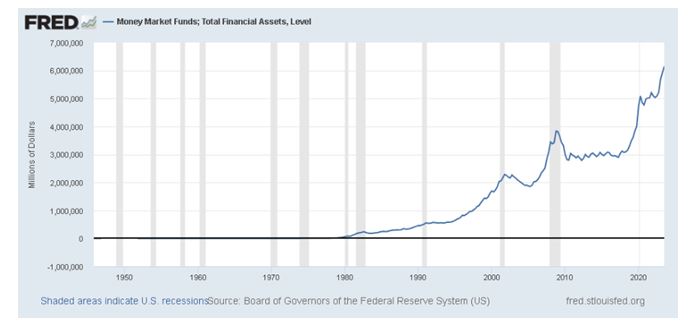
Graphs are for illustrative and discussion purposes only. Please read important disclosures at the end of this commentary.
Also, when rates fall and the market has already run 20% higher, Fear of Missing Out (FOMO) will kick in. Smart money likes to get ahead of this. This, along with seasonality, has powered the market higher.
The BMI will eventually fall from overbought – when, we don’t know. For now, the playbook is to ride the wave until the BMI falls below 80.
If we discovered a probe from another world – would we know what to do with it? Would the other world know what to do with our Voyager probe if they discovered it? For now, we can answer a more pressing question: Can we use a market probe to help us navigate this market successfully? The data says: “Yes.”
![]()
All content above represents the opinion of Jason Bodner of Navellier & Associates, Inc.
Also In This Issue
A Look Ahead by Louis Navellier
Biden’s Clueless Energy Policies May Cost Him Re-Election
Income Mail by Bryan Perry
Sizing Up the New AI-Driven Rally
Growth Mail by Gary Alexander
Ignore All January Indicators, Santa Claus Rallies and Super Bowl Winners
Global Mail by Ivan Martchev
The January Barometer Holds 2024 Promise
Sector Spotlight by Jason Bodner
Market Secrets From “Another Planet”
View Full Archive
Read Past Issues Here

Jason Bodner
MARKETMAIL EDITOR FOR SECTOR SPOTLIGHT
Jason Bodner writes Sector Spotlight in the weekly Marketmail publication and has authored several white papers for the company. He is also Co-Founder of Macro Analytics for Professionals which produces proprietary equity accumulation/distribution research for its clients. Previously, Mr. Bodner served as Director of European Equity Derivatives for Cantor Fitzgerald Europe in London, then moved to the role of Head of Equity Derivatives North America for the same company in New York. He also served as S.V.P. Equity Derivatives for Jefferies, LLC. He received a B.S. in business administration in 1996, with honors, from Skidmore College as a member of the Periclean Honors Society. All content of “Sector Spotlight” represents the opinion of Jason Bodner
Important Disclosures:
Jason Bodner is a co-founder and co-owner of Mapsignals. Mr. Bodner is an independent contractor who is occasionally hired by Navellier & Associates to write an article and or provide opinions for possible use in articles that appear in Navellier & Associates weekly Market Mail. Mr. Bodner is not employed or affiliated with Louis Navellier, Navellier & Associates, Inc., or any other Navellier owned entity. The opinions and statements made here are those of Mr. Bodner and not necessarily those of any other persons or entities. This is not an endorsement, or solicitation or testimonial or investment advice regarding the BMI Index or any statements or recommendations or analysis in the article or the BMI Index or Mapsignals or its products or strategies.
Although information in these reports has been obtained from and is based upon sources that Navellier believes to be reliable, Navellier does not guarantee its accuracy and it may be incomplete or condensed. All opinions and estimates constitute Navellier’s judgment as of the date the report was created and are subject to change without notice. These reports are for informational purposes only and are not a solicitation for the purchase or sale of a security. Any decision to purchase securities mentioned in these reports must take into account existing public information on such securities or any registered prospectus.To the extent permitted by law, neither Navellier & Associates, Inc., nor any of its affiliates, agents, or service providers assumes any liability or responsibility nor owes any duty of care for any consequences of any person acting or refraining to act in reliance on the information contained in this communication or for any decision based on it.
Past performance is no indication of future results. Investment in securities involves significant risk and has the potential for partial or complete loss of funds invested. It should not be assumed that any securities recommendations made by Navellier. in the future will be profitable or equal the performance of securities made in this report. Dividend payments are not guaranteed. The amount of a dividend payment, if any, can vary over time and issuers may reduce dividends paid on securities in the event of a recession or adverse event affecting a specific industry or issuer.
None of the stock information, data, and company information presented herein constitutes a recommendation by Navellier or a solicitation to buy or sell any securities. Any specific securities identified and described do not represent all of the securities purchased, sold, or recommended for advisory clients. The holdings identified do not represent all of the securities purchased, sold, or recommended for advisory clients and the reader should not assume that investments in the securities identified and discussed were or will be profitable.
Information presented is general information that does not take into account your individual circumstances, financial situation, or needs, nor does it present a personalized recommendation to you. Individual stocks presented may not be suitable for every investor. Investment in securities involves significant risk and has the potential for partial or complete loss of funds invested. Investment in fixed income securities has the potential for the investment return and principal value of an investment to fluctuate so that an investor’s holdings, when redeemed, may be worth less than their original cost.
One cannot invest directly in an index. Index is unmanaged and index performance does not reflect deduction of fees, expenses, or taxes. Presentation of Index data does not reflect a belief by Navellier that any stock index constitutes an investment alternative to any Navellier equity strategy or is necessarily comparable to such strategies. Among the most important differences between the Indices and Navellier strategies are that the Navellier equity strategies may (1) incur material management fees, (2) concentrate its investments in relatively few stocks, industries, or sectors, (3) have significantly greater trading activity and related costs, and (4) be significantly more or less volatile than the Indices.
ETF Risk: We may invest in exchange traded funds (“ETFs”) and some of our investment strategies are generally fully invested in ETFs. Like traditional mutual funds, ETFs charge asset-based fees, but they generally do not charge initial sales charges or redemption fees and investors typically pay only customary brokerage fees to buy and sell ETF shares. The fees and costs charged by ETFs held in client accounts will not be deducted from the compensation the client pays Navellier. ETF prices can fluctuate up or down, and a client account could lose money investing in an ETF if the prices of the securities owned by the ETF go down. ETFs are subject to additional risks:
- ETF shares may trade above or below their net asset value;
- An active trading market for an ETF’s shares may not develop or be maintained;
- The value of an ETF may be more volatile than the underlying portfolio of securities the ETF is designed to track;
- The cost of owning shares of the ETF may exceed those a client would incur by directly investing in the underlying securities; and
- Trading of an ETF’s shares may be halted if the listing exchange’s officials deem it appropriate, the shares are delisted from the exchange, or the activation of market-wide “circuit breakers” (which are tied to large decreases in stock prices) halts stock trading generally.
Grader Disclosures: Investment in equity strategies involves substantial risk and has the potential for partial or complete loss of funds invested. The sample portfolio and any accompanying charts are for informational purposes only and are not to be construed as a solicitation to buy or sell any financial instrument and should not be relied upon as the sole factor in an investment making decision. As a matter of normal and important disclosures to you, as a potential investor, please consider the following: The performance presented is not based on any actual securities trading, portfolio, or accounts, and the reported performance of the A, B, C, D, and F portfolios (collectively the “model portfolios”) should be considered mere “paper” or pro forma performance results based on Navellier’s research.
Investors evaluating any of Navellier & Associates, Inc.’s, (or its affiliates’) Investment Products must not use any information presented here, including the performance figures of the model portfolios, in their evaluation of any Navellier Investment Products. Navellier Investment Products include the firm’s mutual funds and managed accounts. The model portfolios, charts, and other information presented do not represent actual funded trades and are not actual funded portfolios. There are material differences between Navellier Investment Products’ portfolios and the model portfolios, research, and performance figures presented here. The model portfolios and the research results (1) may contain stocks or ETFs that are illiquid and difficult to trade; (2) may contain stock or ETF holdings materially different from actual funded Navellier Investment Product portfolios; (3) include the reinvestment of all dividends and other earnings, estimated trading costs, commissions, or management fees; and, (4) may not reflect prices obtained in an actual funded Navellier Investment Product portfolio. For these and other reasons, the reported performances of model portfolios do not reflect the performance results of Navellier’s actually funded and traded Investment Products. In most cases, Navellier’s Investment Products have materially lower performance results than the performances of the model portfolios presented.
This report contains statements that are, or may be considered to be, forward-looking statements. All statements that are not historical facts, including statements about our beliefs or expectations, are “forward-looking statements” within the meaning of The U.S. Private Securities Litigation Reform Act of 1995. These statements may be identified by such forward-looking terminology as “expect,” “estimate,” “plan,” “intend,” “believe,” “anticipate,” “may,” “will,” “should,” “could,” “continue,” “project,” or similar statements or variations of such terms. Our forward-looking statements are based on a series of expectations, assumptions, and projections, are not guarantees of future results or performance, and involve substantial risks and uncertainty as described in Form ADV Part 2A of our filing with the Securities and Exchange Commission (SEC), which is available at www.adviserinfo.sec.gov or by requesting a copy by emailing info@navellier.com. All of our forward-looking statements are as of the date of this report only. We can give no assurance that such expectations or forward-looking statements will prove to be correct. Actual results may differ materially. You are urged to carefully consider all such factors.
FEDERAL TAX ADVICE DISCLAIMER: As required by U.S. Treasury Regulations, you are informed that, to the extent this presentation includes any federal tax advice, the presentation is not written by Navellier to be used, and cannot be used, for the purpose of avoiding federal tax penalties. Navellier does not advise on any income tax requirements or issues. Use of any information presented by Navellier is for general information only and does not represent tax advice either express or implied. You are encouraged to seek professional tax advice for income tax questions and assistance.
IMPORTANT NEWSLETTER DISCLOSURE:The hypothetical performance results for investment newsletters that are authored or edited by Louis Navellier, including Louis Navellier’s Growth Investor, Louis Navellier’s Breakthrough Stocks, Louis Navellier’s Accelerated Profits, and Louis Navellier’s Platinum Club, are not based on any actual securities trading, portfolio, or accounts, and the newsletters’ reported hypothetical performances should be considered mere “paper” or proforma hypothetical performance results and are not actual performance of real world trades. Navellier & Associates, Inc. does not have any relation to or affiliation with the owner of these newsletters. There are material differences between Navellier Investment Products’ portfolios and the InvestorPlace Media, LLC newsletter portfolios authored by Louis Navellier. The InvestorPlace Media, LLC newsletters contain hypothetical performance that do not include transaction costs, advisory fees, or other fees a client might incur if actual investments and trades were being made by an investor. As a result, newsletter performance should not be used to evaluate Navellier Investment services which are separate and different from the newsletters. The owner of the newsletters is InvestorPlace Media, LLC and any questions concerning the newsletters, including any newsletter advertising or hypothetical Newsletter performance claims, (which are calculated solely by Investor Place Media and not Navellier) should be referred to InvestorPlace Media, LLC at (800) 718-8289.
Please note that Navellier & Associates and the Navellier Private Client Group are managed completely independent of the newsletters owned and published by InvestorPlace Media, LLC and written and edited by Louis Navellier, and investment performance of the newsletters should in no way be considered indicative of potential future investment performance for any Navellier & Associates separately managed account portfolio. Potential investors should consult with their financial advisor before investing in any Navellier Investment Product.
Navellier claims compliance with Global Investment Performance Standards (GIPS). To receive a complete list and descriptions of Navellier’s composites and/or a presentation that adheres to the GIPS standards, please contact Navellier or click here. It should not be assumed that any securities recommendations made by Navellier & Associates, Inc. in the future will be profitable or equal the performance of securities made in this report.
FactSet Disclosure: Navellier does not independently calculate the statistical information included in the attached report. The calculation and the information are provided by FactSet, a company not related to Navellier. Although information contained in the report has been obtained from FactSet and is based on sources Navellier believes to be reliable, Navellier does not guarantee its accuracy, and it may be incomplete or condensed. The report and the related FactSet sourced information are provided on an “as is” basis. The user assumes the entire risk of any use made of this information. Investors should consider the report as only a single factor in making their investment decision. The report is for informational purposes only and is not intended as an offer or solicitation for the purchase or sale of a security. FactSet sourced information is the exclusive property of FactSet. Without prior written permission of FactSet, this information may not be reproduced, disseminated or used to create any financial products. All indices are unmanaged and performance of the indices include reinvestment of dividends and interest income, unless otherwise noted, are not illustrative of any particular investment and an investment cannot be made in any index. Past performance is no guarantee of future results.
